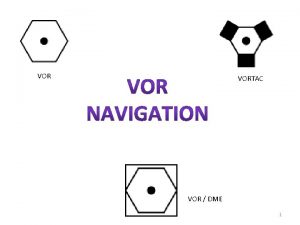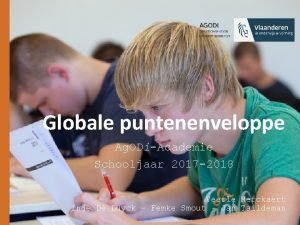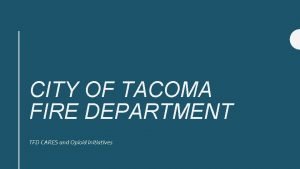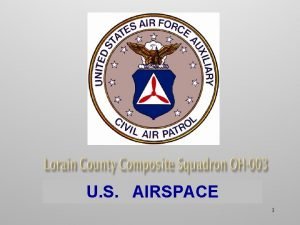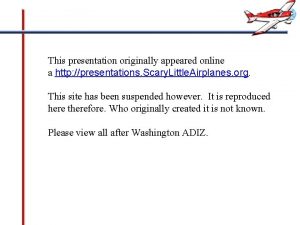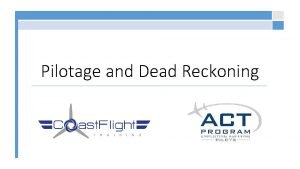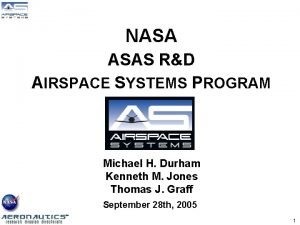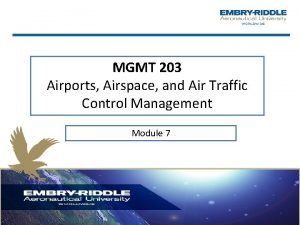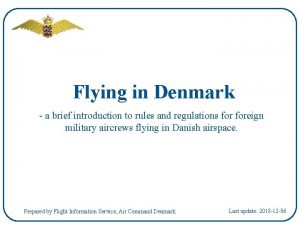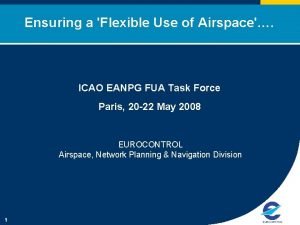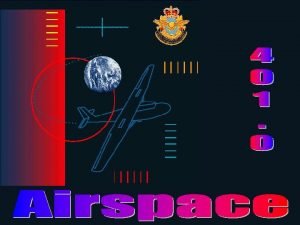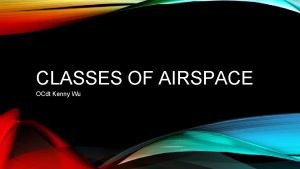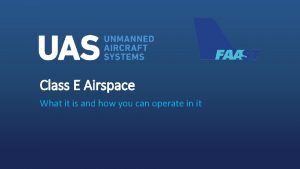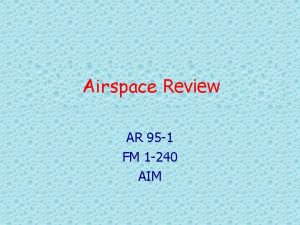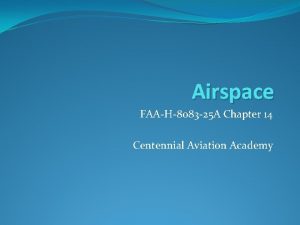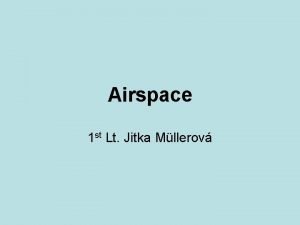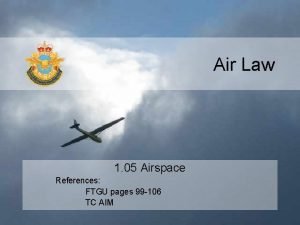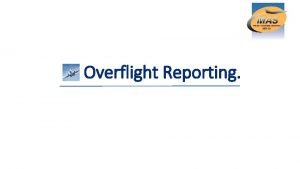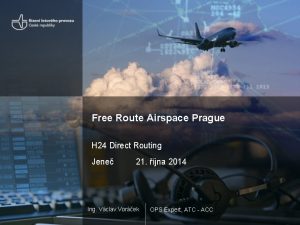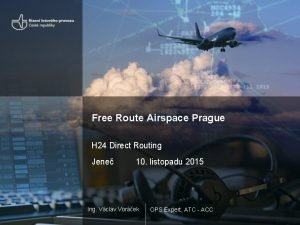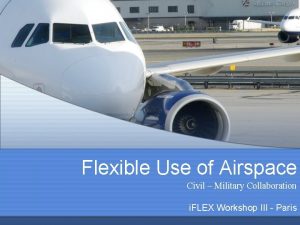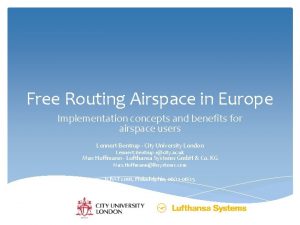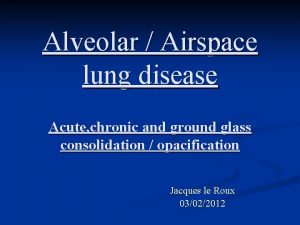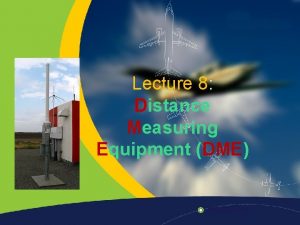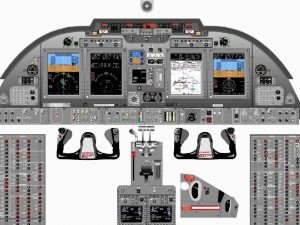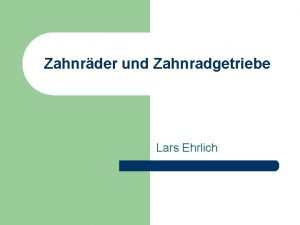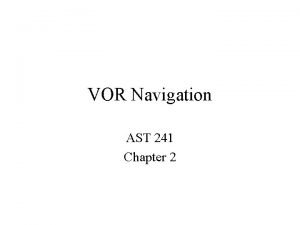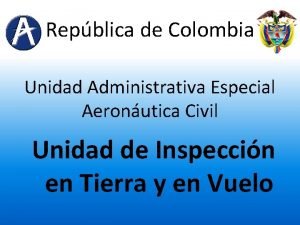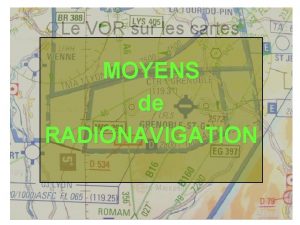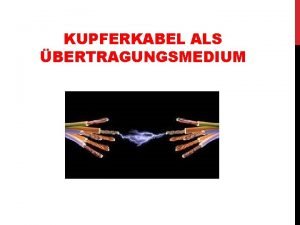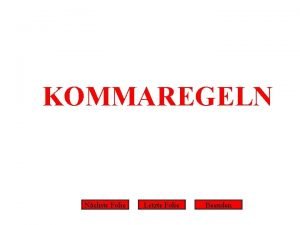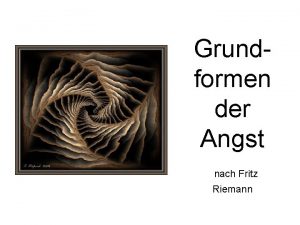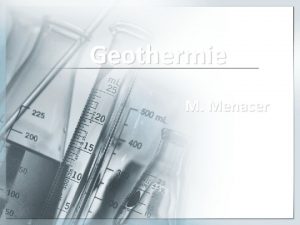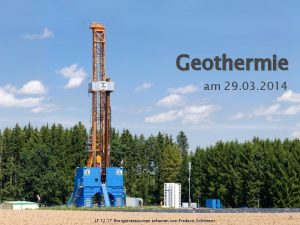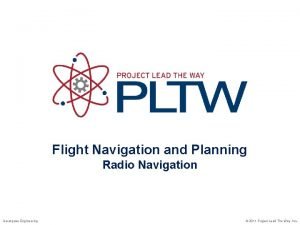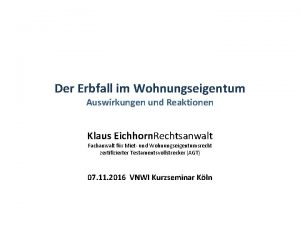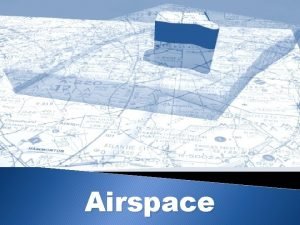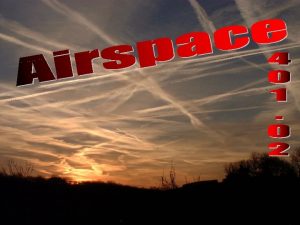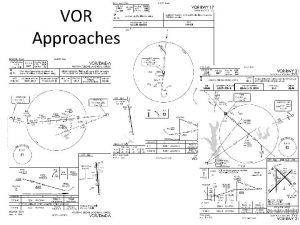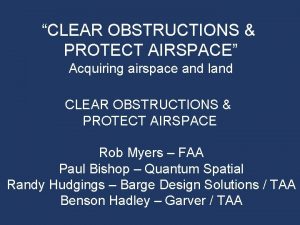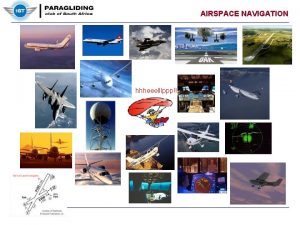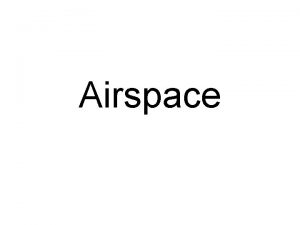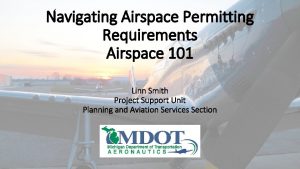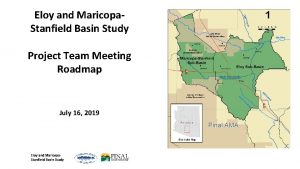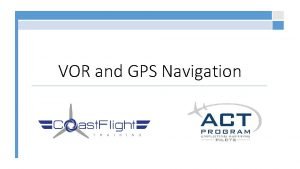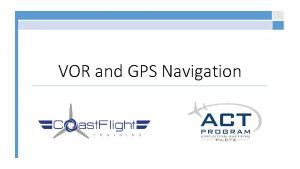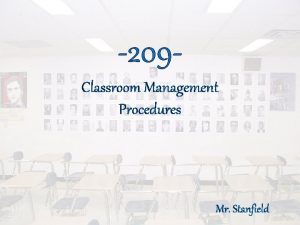The airspace around the Stanfield VOR TFD and












































- Slides: 44

The airspace around the Stanfield VOR (TFD) and Casa Grande Airport (KCGZ) is extremely congested with training aircraft. This is primarily due to the fact that the ILS approach to runway 5 at CGZ is one of the only precision approaches available to the many flight training providers in the Phoenix area. That, combined with the Class E airspace and lack of radar coverage, puts this area at high-risk for mid-air collisions. The following procedures are provided as recommendations and best practices to improve communication and provide a safe training environment at and around the Stanfield VOR. Following these procedures is highly recommended, but not mandatory. Please contact the AFTW (at aftw. org) with any questions or concerns regarding these recommended procedures. IMPORTANT NOTE: Everyone following these procedures needs to remember to be patient with, and understanding of, other pilots who are not familiar with these procedures. Those of us who fly these procedures regularly may start to think that this is "the only way" or "the right way" for everything to be done, thereby leading to us think that someone else is "doing it wrong. " Please remember that these are unofficial procedures that are not known to many other pilots. When it becomes apparent that there is someone attempting to transit the area and/or practice an instrument approach without following the recommended procedures, the instructor/evaluator currently at the "top of stack" should ask the unfamiliar pilot if they would like help joining the flow of traffic and then proceed to guide that pilot through the procedures as needed. Please be careful to not sound frustrated or inconvenienced while doing this. It is appropriate to kindly make a brief radio call to suggest that unfamiliar pilots obtain these procedures at aftw. org before their next flight. Please remember to be patient, courteous, and professional at all times. Thank you!

Summary of Significant Changes in this Revision In an effort to reduce radio congestion, the following calls have been removed: Entering the stack Turning in the hold Procedure turn outbound 6 NM final Changed “ 3800 ft. Open” to “Approach altitudes open, ” when VOR inbound. Removed "Suggested entry altitude 4500 ft. MSL" note, making it okay to enter at approach altitudes when the stack is empty. Cleaned up text in the example radio calls on several slides. Added cautions about ADS-B (slide 34). After making the above changes, the only standardized calls are: About 10 NM out (state how many minutes out) - Request top of stack 2 minutes out Every altitude change Procedure turn inbound (please follow the definition in the Pilot / Controller Glossary) VOR inbound, approach altitudes open 4 NM final to runway 05 at KCGZ 2 NM final to runway 05 at KCGZ

Stanfield VOR Procedures This Power. Point is not intended as a directive. It is intended to serve as a tool to communicate the training community’s best practices. Any questions or concerns to these procedures are welcome by contacting the Arizona Flight Training Workgroup (http: //aftw. org). Revision 6 Revision date: 05 JUN 2020

Stanfield VOR Procedures Dimensions Simulated IFR Procedures Radio Tips Calls

Stanfield VOR Procedures Dimensions

Stanfield VOR Procedures Dimensions Simulated IFR Procedures Radio Calls Tips Depiction on Low Altitude IFR Chart

Stanfield VOR Procedures Dimensions Simulated IFR Procedures Radio Calls Tips Depiction on VFR Terminal Area Chart

Stanfield VOR Procedures Dimensions Simulated IFR Procedures Radio Calls Tips Depiction on VFR Sectional Chart

Stanfield VOR training area laterally extends up to 10 NM - 12 NM from the TFD VOR Stanfield VOR Procedures Dimensions Simulated IFR Procedures Radio Calls Tips 10 NM – 12 NM

Stanfield VOR Procedures Dimensions Stanfield VOR training area extends vertically up to 7500 ft. MSL 10 – 12 NM Simulated IFR Procedures Radio Calls Tips Up to 7500 ft. MSL

Stack altitudes are separated by 500 ft. Stanfield VOR Procedures Dimensions Simulated IFR Procedures 6500 ft. MSL Radio Calls 5500 ft. MSL Tips 7000 ft. MSL 6000 ft. MSL 5000 ft. MSL 4500 ft. MSL

Stanfield VOR Procedures Simulated IFR Procedures

Several IFR Procedures using ‘the stack’ KCGZ ILS or LOC RWY 05 Starts at 3800 ft. MSL Stanfield VOR Procedures KCGZ VOR/DME RWY 05 Starts at 3500 ft. MSL Dimensions KCGZ RNAV (GPS) RWY 05 Starts at 3800 ft. MSL Simulated IFR Procedures Radio Calls Tips ILS Rwy 05

Useable Altitudes 4, 500 is the lowest useable altitude to hold and await your turn to shoot the approach. Any altitude below 4, 500 is referred to as “Approach Altitudes” and is reserved for shooting the approaches at the appropriate starting altitude for the approach you wish to practice. Above 4, 500, each aircraft stacks at 500 ft. increments awaiting turn to drop down and shoot the approach. Stanfield VOR Procedures Dimensions Simulated IFR Procedures Radio Calls Tips

Stanfield VOR Procedures Several IFR Procedures using the stack Idea is to occupy next available altitude above the top-of-stack and drop down in the stack, one airplane at a time as altitudes become available. Drop 500 ft. per descent to next stack holding altitude until at 4, 500 MSL. Make sure nobody is below you and visually clear the altitude below. When in doubt, CALL! Once you reach starting altitude, initiate approach when ready. Dimensions Simulated IFR Procedures Radio Calls Tips Top-of-stack = highest occupied altitude in ‘the stack’

Stanfield VOR Procedures Dimensions Simulated IFR Procedures Radio Calls Tips Missed Approach Procedures The missed approach procedures for IFR approaches lead an aircraft back to ‘the stack. ’ When on the missed approach, as soon as practical, communicate with aircraft in ‘the stack. ’

Stanfield VOR Procedures If performing holdings / tracking / interceptions only Leave the lower altitudes in ‘the stack’ for airplanes flying IFR approaches. The AFTW suggests holding at 7000 ft. MSL, or as appropriate for the traffic. If holding aircraft intend to accomplish a practice approach, they can work their way into the stack as they near the end of their holding practice. Dimensions Simulated IFR Procedures Radio Calls Tips

Stanfield VOR Procedures Radio Calls

Stanfield VOR Procedures Dimensions Simulated IFR Procedures Radio Calls Tips Calls should be as short and precise as possible. Should be made by instructor/evaluator, not the pilot in training Students already have enough to think about! The instructor/evaluator should simulate realistic IFR ATC calls to the pilot in training (over the intercom) Tip: Check out Live. ATC. net for KCGZ CTAF audio recordings and live feed.

Stanfield VOR Procedures When approaching the stack (12 NM out), start monitoring 122. 70, even if you are not intending to use it (e. g. : VFR nav. ) If you are within 10 NM of the stack, make position reports on 122. 70 Dimensions Simulated IFR Procedures Radio Calls Tips … MONITOR …

Stanfield VOR Procedures When approaching the stack (12 NM out), start monitoring 122. 70, even if you are not intending to use it (e. g. : VFR nav. ) If you are within 10 NM of the stack, make position reports on 122. 70 Dimensions Simulated IFR Procedures Radio Calls Tips “Stanfield traffic, Cherokee 789, 6 NM northwest of Stanfield, 5, 500 ft. , eastbound”

Stanfield VOR Procedures Dimensions Simulated IFR Procedures If you intend to use the stack: Make a last call on the practice area frequency (122. 85) Make an initial call on 122. 70 10 NM from Stanfield VOR 12 NM Radio Calls Tips “Southwest Practice Area, Cessna 123, 5 NM east of North Test Track, 4, 500 ft. , southwest bound to Stanfield, last call”

Stanfield VOR Procedures Dimensions Simulated IFR Procedures First call to be made 10 NM out Ask for top-of-stack Listen carefully to the current top-of -stack and occupy the next available altitude. Announce intentions 10 NM Radio Calls Tips “Stanfield Traffic, Cessna 123, 5 minutes north of Stanfield, 4, 500 ft. , request topof-stack”

Stanfield VOR Procedures Dimensions Simulated IFR Procedures First call to be made 10 NM out Ask for top-of-stack Listen carefully to the current top-of -stack and occupy the next available altitude. Announce intentions 10 NM Radio Calls Tips “Stanfield Traffic, Seminole 789, procedure turn outbound, 3, 800 ft. top-of-stack. ”

Stanfield VOR Procedures Dimensions Simulated IFR Procedures First call to be made 10 NM out Ask for top-of-stack Listen carefully to the current top-of -stack and occupy the next available altitude. Announce intentions 10 NM Radio Calls Tips “Stanfield Traffic, Cessna 123, 5 minutes north of Stanfield, 10 DME, taking top-of-stack at 4, 500 ft. ”

Next call to be made at about 5 NM (2 minutes) out Stanfield VOR Procedures Announce intentions to take the next open altitude of 4, 500 (4, 000 is NOT an option because it conflicts with approaches) Dimensions Simulated IFR Procedures Radio Calls Tips 5 NM “Stanfield Traffic, Cessna 123, 2 minutes north of Stanfield, 5 DME, taking 4, 500 ft. ”

Stanfield VOR Procedures Next call to be made when descending Announce intentions and clearly announce vacated altitude is ‘OPEN’ Wait until next altitude is ‘OPEN’ before descending! Dimensions Simulated IFR Procedures Radio Calls Tips Descending in stack “Stanfield Traffic, Cessna 123, descending to 3, 800, 4, 500 open”

Next call to be made when procedure turn inbound Stanfield VOR Procedures Dimensions Simulated IFR Procedures Radio Calls Tips This call lets everyone know you are finished holding and about to shoot the approach Procedure turn inbound “Stanfield Traffic, Cessna 123, 3, 800, procedure turn inbound”

Next call to be made when starting the approach (overhead the TFD VOR) Stanfield VOR Procedures Dimensions Simulated IFR Procedures Announce intentions and report vacated altitude ‘OPEN’ Starting approach Radio Calls Tips “Stanfield Traffic, Cessna 123, VOR inbound, approach altitudes are open”

Stanfield VOR Procedures While on the approach, an inbound call should be made on a 4 NM and 2 NM final to allow VFR aircraft in the Casa Grande pattern to govern their approaches. Report to Casa Grande traffic instead of Stanfield Traffic from this moment on. Dimensions Simulated IFR Procedures Radio Calls Tips “ 4 NM final” “ 2 NM final”

Next call to be made when 4 NM final Announce intentions and closely monitor KCGZ traffic! Stanfield VOR Procedures Dimensions Simulated IFR Procedures Radio Calls 4 NM Tips “Casa Grande traffic, Cessna 123, 4 mile final runway 5, Casa Grande”

Next call to be made when 2 NM final Stanfield VOR Procedures Dimensions Simulated IFR Procedures Radio Calls Tips Announce intentions and closely monitor KCGZ traffic! “Casa Grande traffic, Twinstar 456, 2 mile final runway 5, Casa Grande”

Stanfield VOR Procedures Dimensions Simulated IFR Procedures Radio Calls Tips The procedure turn inbound call should only be made in conjunction with the initiation of the instrument approach procedure and not when making circuits in the holding pattern. The procedure turn inbound callout should be made when the aircraft is established on the 228° radial inbound (pointing northeast), not at the beginning of the turn inbound.

A Few Notes About ADS-B Stanfield VOR Procedures Dimensions Simulated IFR Procedures ADS-B is a wonderful tool to help in determining the position of traffic we hear on frequency. It’s human nature to fall into the mindset that everyone we see/hear is everyone that’s there. This is a dangerous assumption. Please keep your visual scan going and remember: Pilots are not required to be talking on CTAF around the Stanfield VOR. Pilots may be operating legally in this area without ADS-B Out. Even when it’s installed and working, ADS-B is not flawless. Radio Calls Tips

Stanfield VOR Procedures Tips

What runway in use? Everyone practicing instrument approaches typically accepts up to a 10 knot tailwind component for runway 05 before using circling procedures for runway 23. Runway 23 is established as the active runway as soon as the first pilot selects and uses it as the runway in use. Other arriving aircraft should conform to the established runway in use whenever anyone remains in the traffic pattern. Conform to right-of-way rules Stanfield VOR Procedures Dimensions Simulated IFR Procedures Radio Calls Tips

Simulated radar vectors Stanfield VOR Procedures Dimensions Simulated IFR Procedures Radio Calls Tips If an instructor/evaluator elects to provide simulated radar vectors to the final approach course they should give way to all other aircraft proceeding via the full published route structure.

Missed Approach Procedures When flying the published missed approach for runway 05 it is recommended to return to the VOR above top-of-stack. Be cautious for IFR aircraft under ABQ CENTER control! Stanfield VOR Procedures Dimensions Simulated IFR Procedures Radio Calls Tips

Touch-and-go RWY 05 with Missed Approach Procedure Stanfield VOR Procedures Dimensions Simulated IFR Procedures Radio Calls Tips When flying the initial takeoff or touch-and-go, make a right downwind departure towards TFD VOR. This will keep you clear of the PJE north of the airport.

Stanfield VOR Procedures Dimensions Simulated IFR Procedures Radio Calls Tips When flying Missed Approach Procedure Avoid incoming traffic on the IFR approaches! Recommend to proceeded 2 NM south of KCGZ, then turn back to the VOR

Stanfield VOR Procedures Dimensions Simulated IFR Procedures Radio Calls Tips Due to risk of opposite direction approaches and frequent near mid air collisions, AFTW recommends that VFR training aircraft do not fly the GPS Rwy 23 approach into KCGZ.

Have landing light on from VOR inbound to KCGZ Announce intentions when approach terminates so traffic following you can properly separate. Speak clearly Stanfield VOR Procedures Perform good visual lookout Dimensions Be courteous and kind to one another Simulated IFR Procedures Stay professional Radio Calls Have fun! Tips

Closing Thoughts NOTE: The AFTW is currently working on standardized procedures to better coordinate real and simulated IFR traffic at TFD and CGZ. Please submit your suggestions at: http: //aftw. org/contact/ Please be aware that: This procedure is for VFR aircraft only. IFR aircraft must abide by ATC clearances and regulations. Aircraft operating IFR that are unfamiliar with these procedures may be instructed to enter the stack by Albuquerque Center at any altitude. Aircraft from out of state or users who are not familiar with these procedures will not be using them. Please be patient and kind. Keep you eyes out to see and avoid other traffic!

 Cell manufacturing
Cell manufacturing Vor dme vortac
Vor dme vortac Globale puntenenveloppe secundair onderwijs
Globale puntenenveloppe secundair onderwijs Tfd cares
Tfd cares Example of what goes around comes around
Example of what goes around comes around Goes around comes around meaning
Goes around comes around meaning Class g airspace dimensions
Class g airspace dimensions Airspace entry requirements
Airspace entry requirements W291 airspace
W291 airspace Airspace
Airspace Airspace zones
Airspace zones Denmark airspace
Denmark airspace Flexible use of airspace
Flexible use of airspace Northern domestic airspace canada
Northern domestic airspace canada Classes of airspace
Classes of airspace Airspace
Airspace The lateral dimensions of class d airspace
The lateral dimensions of class d airspace Centennial aviation academy
Centennial aviation academy Airspace definition
Airspace definition East is least west is best
East is least west is best Mexican airspace
Mexican airspace Airspace design analysis sterling va
Airspace design analysis sterling va Free route airspace
Free route airspace Free route airspace czech republic
Free route airspace czech republic Flexible use of airspace
Flexible use of airspace Free route airspace europe
Free route airspace europe Perihilum
Perihilum Dme distance formula
Dme distance formula Phases of vor
Phases of vor Zahnradgetriebe vor und nachteile
Zahnradgetriebe vor und nachteile Lee vor luv beispiele
Lee vor luv beispiele How to use vor
How to use vor Terminal vor range
Terminal vor range Vor colombia
Vor colombia Rose des qdm
Rose des qdm Twisted pair kabel
Twisted pair kabel Je desto beispiel
Je desto beispiel When is an ifr flight plan required?
When is an ifr flight plan required? Grundformen der angst riemann zusammenfassung
Grundformen der angst riemann zusammenfassung Geothermie
Geothermie Erdwärmekraftwerk vor und nachteile
Erdwärmekraftwerk vor und nachteile Cdi deflection distance
Cdi deflection distance Daimler global player
Daimler global player Vor und nacherbschaft
Vor und nacherbschaft Teilnehmen an dat oder akk
Teilnehmen an dat oder akk

